Analysis of HR Practices, Models, and Strategies at PepsiCo
VerifiedAdded on 2020/10/23
|20
|5623
|1243
Report
AI Summary
This report provides a comprehensive analysis of PepsiCo's Human Resources (HR) function. It begins with an introduction to PepsiCo's business overview and its HR agenda, emphasizing the importance of human resources for gaining a competitive advantage. The report then delves into the HR models followed by PepsiCo, specifically the Warwick and Ulrich models, illustrating how these frameworks shape HR strategies. It also examines the influence of external factors, such as economic and political conditions, on HR practices. A comparison between SWOT and PESTLE analyses is presented, highlighting their strengths and weaknesses in the context of PepsiCo. The report further explores the effect of internal and external factors on the HR function, the stages in strategy formulation, and the role of HR in strategy implementation, business ethics, corporate social responsibility (CSR), and corporate governance. Additionally, it discusses HR's role in change management, including the Kurt Lewin model, and the use of HR and business metrics in the planning process. The report concludes with a summary of the key findings and references for further study.
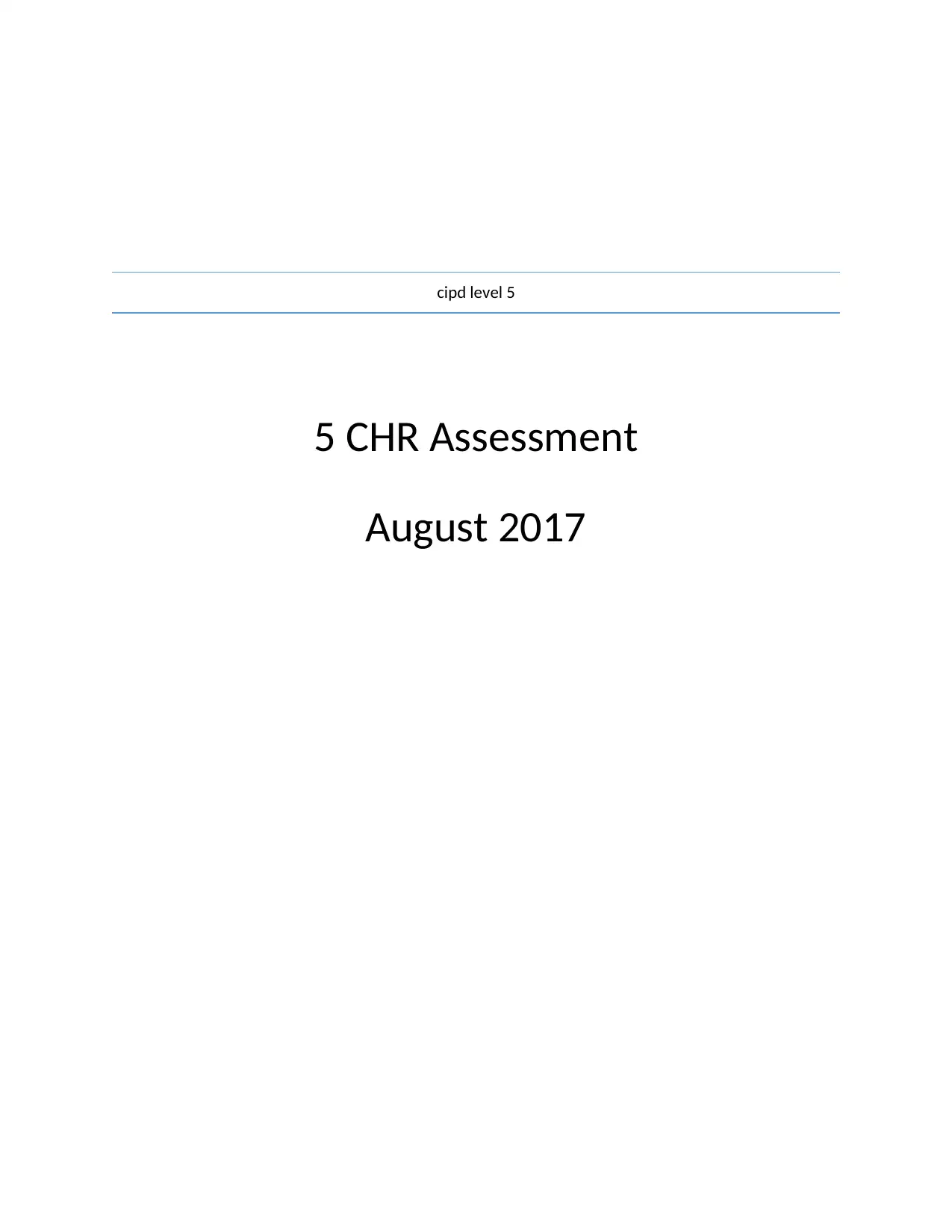
cipd level 5
5 CHR Assessment
August 2017
5 CHR Assessment
August 2017
Paraphrase This Document
Need a fresh take? Get an instant paraphrase of this document with our AI Paraphraser
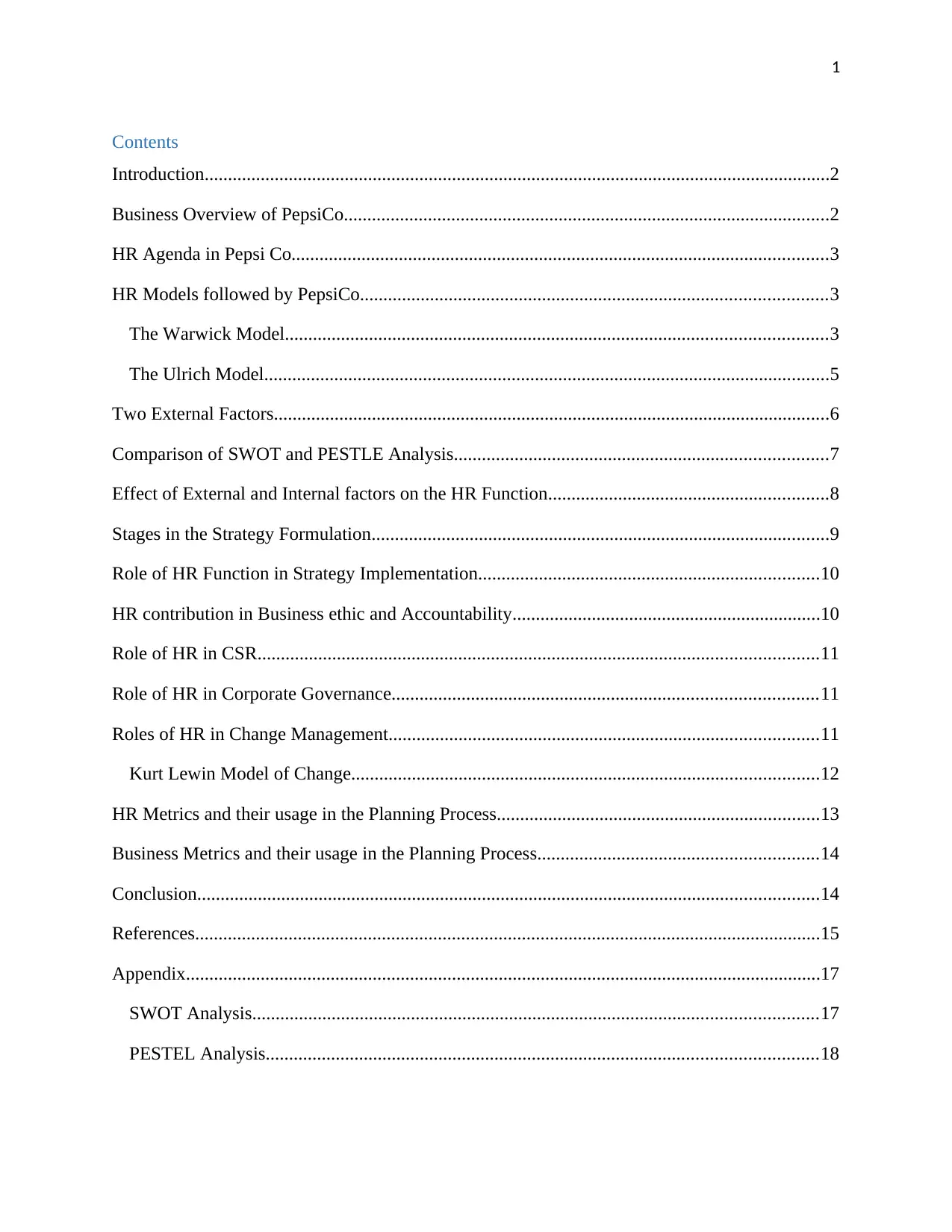
1
Contents
Introduction......................................................................................................................................2
Business Overview of PepsiCo........................................................................................................2
HR Agenda in Pepsi Co...................................................................................................................3
HR Models followed by PepsiCo....................................................................................................3
The Warwick Model....................................................................................................................3
The Ulrich Model.........................................................................................................................5
Two External Factors.......................................................................................................................6
Comparison of SWOT and PESTLE Analysis................................................................................7
Effect of External and Internal factors on the HR Function............................................................8
Stages in the Strategy Formulation..................................................................................................9
Role of HR Function in Strategy Implementation.........................................................................10
HR contribution in Business ethic and Accountability..................................................................10
Role of HR in CSR........................................................................................................................11
Role of HR in Corporate Governance...........................................................................................11
Roles of HR in Change Management............................................................................................11
Kurt Lewin Model of Change....................................................................................................12
HR Metrics and their usage in the Planning Process.....................................................................13
Business Metrics and their usage in the Planning Process............................................................14
Conclusion.....................................................................................................................................14
References......................................................................................................................................15
Appendix........................................................................................................................................17
SWOT Analysis.........................................................................................................................17
PESTEL Analysis......................................................................................................................18
Contents
Introduction......................................................................................................................................2
Business Overview of PepsiCo........................................................................................................2
HR Agenda in Pepsi Co...................................................................................................................3
HR Models followed by PepsiCo....................................................................................................3
The Warwick Model....................................................................................................................3
The Ulrich Model.........................................................................................................................5
Two External Factors.......................................................................................................................6
Comparison of SWOT and PESTLE Analysis................................................................................7
Effect of External and Internal factors on the HR Function............................................................8
Stages in the Strategy Formulation..................................................................................................9
Role of HR Function in Strategy Implementation.........................................................................10
HR contribution in Business ethic and Accountability..................................................................10
Role of HR in CSR........................................................................................................................11
Role of HR in Corporate Governance...........................................................................................11
Roles of HR in Change Management............................................................................................11
Kurt Lewin Model of Change....................................................................................................12
HR Metrics and their usage in the Planning Process.....................................................................13
Business Metrics and their usage in the Planning Process............................................................14
Conclusion.....................................................................................................................................14
References......................................................................................................................................15
Appendix........................................................................................................................................17
SWOT Analysis.........................................................................................................................17
PESTEL Analysis......................................................................................................................18
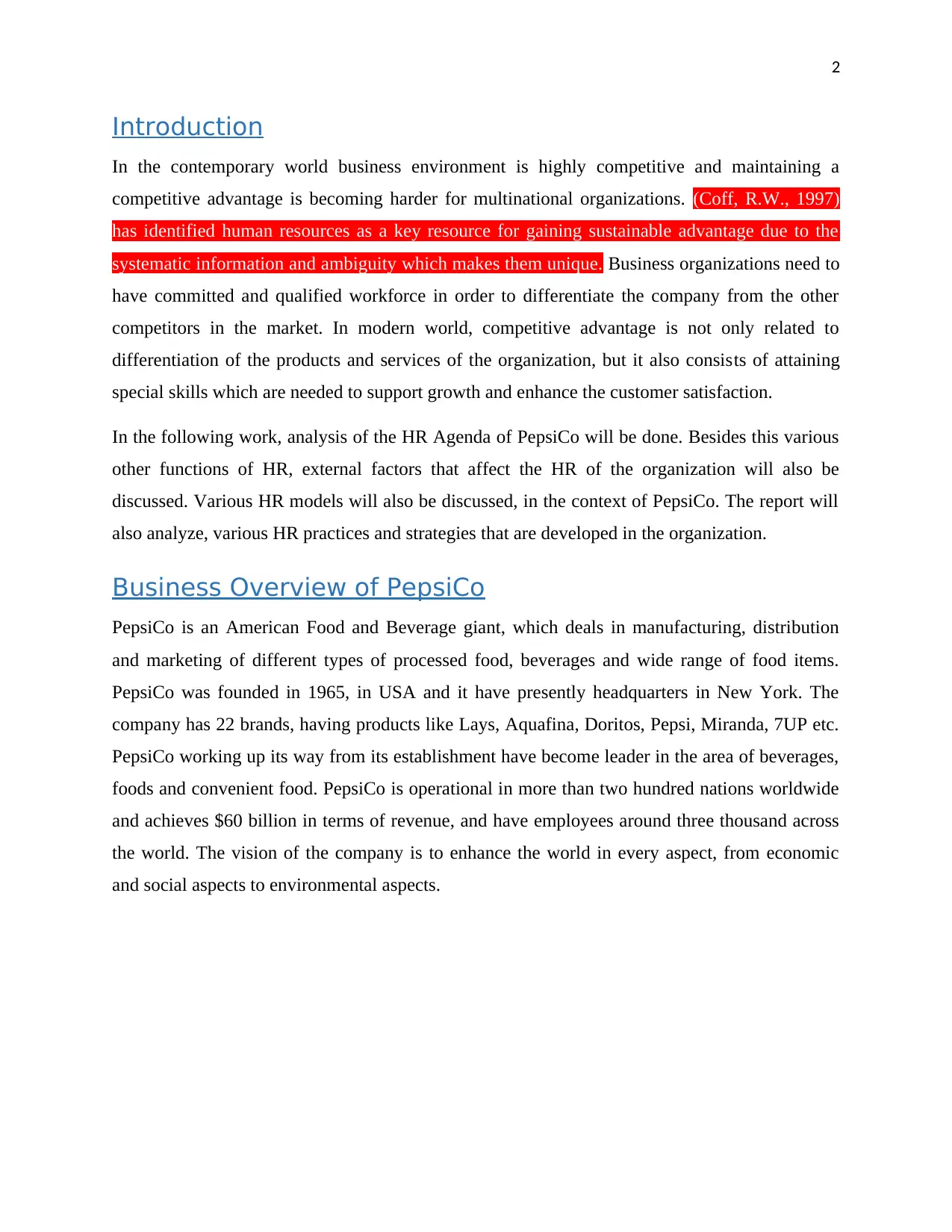
2
Introduction
In the contemporary world business environment is highly competitive and maintaining a
competitive advantage is becoming harder for multinational organizations. (Coff, R.W., 1997)
has identified human resources as a key resource for gaining sustainable advantage due to the
systematic information and ambiguity which makes them unique. Business organizations need to
have committed and qualified workforce in order to differentiate the company from the other
competitors in the market. In modern world, competitive advantage is not only related to
differentiation of the products and services of the organization, but it also consists of attaining
special skills which are needed to support growth and enhance the customer satisfaction.
In the following work, analysis of the HR Agenda of PepsiCo will be done. Besides this various
other functions of HR, external factors that affect the HR of the organization will also be
discussed. Various HR models will also be discussed, in the context of PepsiCo. The report will
also analyze, various HR practices and strategies that are developed in the organization.
Business Overview of PepsiCo
PepsiCo is an American Food and Beverage giant, which deals in manufacturing, distribution
and marketing of different types of processed food, beverages and wide range of food items.
PepsiCo was founded in 1965, in USA and it have presently headquarters in New York. The
company has 22 brands, having products like Lays, Aquafina, Doritos, Pepsi, Miranda, 7UP etc.
PepsiCo working up its way from its establishment have become leader in the area of beverages,
foods and convenient food. PepsiCo is operational in more than two hundred nations worldwide
and achieves $60 billion in terms of revenue, and have employees around three thousand across
the world. The vision of the company is to enhance the world in every aspect, from economic
and social aspects to environmental aspects.
Introduction
In the contemporary world business environment is highly competitive and maintaining a
competitive advantage is becoming harder for multinational organizations. (Coff, R.W., 1997)
has identified human resources as a key resource for gaining sustainable advantage due to the
systematic information and ambiguity which makes them unique. Business organizations need to
have committed and qualified workforce in order to differentiate the company from the other
competitors in the market. In modern world, competitive advantage is not only related to
differentiation of the products and services of the organization, but it also consists of attaining
special skills which are needed to support growth and enhance the customer satisfaction.
In the following work, analysis of the HR Agenda of PepsiCo will be done. Besides this various
other functions of HR, external factors that affect the HR of the organization will also be
discussed. Various HR models will also be discussed, in the context of PepsiCo. The report will
also analyze, various HR practices and strategies that are developed in the organization.
Business Overview of PepsiCo
PepsiCo is an American Food and Beverage giant, which deals in manufacturing, distribution
and marketing of different types of processed food, beverages and wide range of food items.
PepsiCo was founded in 1965, in USA and it have presently headquarters in New York. The
company has 22 brands, having products like Lays, Aquafina, Doritos, Pepsi, Miranda, 7UP etc.
PepsiCo working up its way from its establishment have become leader in the area of beverages,
foods and convenient food. PepsiCo is operational in more than two hundred nations worldwide
and achieves $60 billion in terms of revenue, and have employees around three thousand across
the world. The vision of the company is to enhance the world in every aspect, from economic
and social aspects to environmental aspects.
⊘ This is a preview!⊘
Do you want full access?
Subscribe today to unlock all pages.

Trusted by 1+ million students worldwide
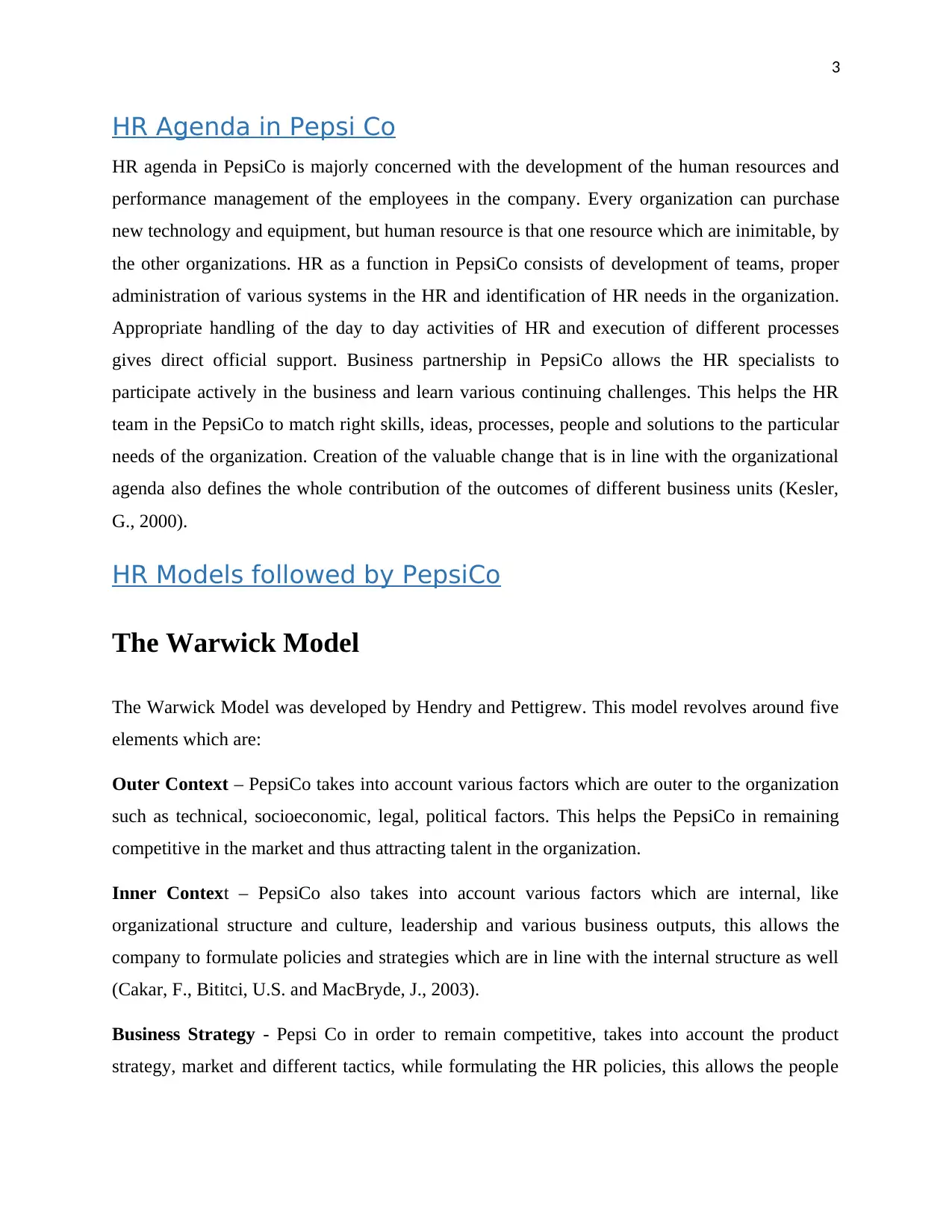
3
HR Agenda in Pepsi Co
HR agenda in PepsiCo is majorly concerned with the development of the human resources and
performance management of the employees in the company. Every organization can purchase
new technology and equipment, but human resource is that one resource which are inimitable, by
the other organizations. HR as a function in PepsiCo consists of development of teams, proper
administration of various systems in the HR and identification of HR needs in the organization.
Appropriate handling of the day to day activities of HR and execution of different processes
gives direct official support. Business partnership in PepsiCo allows the HR specialists to
participate actively in the business and learn various continuing challenges. This helps the HR
team in the PepsiCo to match right skills, ideas, processes, people and solutions to the particular
needs of the organization. Creation of the valuable change that is in line with the organizational
agenda also defines the whole contribution of the outcomes of different business units (Kesler,
G., 2000).
HR Models followed by PepsiCo
The Warwick Model
The Warwick Model was developed by Hendry and Pettigrew. This model revolves around five
elements which are:
Outer Context – PepsiCo takes into account various factors which are outer to the organization
such as technical, socioeconomic, legal, political factors. This helps the PepsiCo in remaining
competitive in the market and thus attracting talent in the organization.
Inner Context – PepsiCo also takes into account various factors which are internal, like
organizational structure and culture, leadership and various business outputs, this allows the
company to formulate policies and strategies which are in line with the internal structure as well
(Cakar, F., Bititci, U.S. and MacBryde, J., 2003).
Business Strategy - Pepsi Co in order to remain competitive, takes into account the product
strategy, market and different tactics, while formulating the HR policies, this allows the people
HR Agenda in Pepsi Co
HR agenda in PepsiCo is majorly concerned with the development of the human resources and
performance management of the employees in the company. Every organization can purchase
new technology and equipment, but human resource is that one resource which are inimitable, by
the other organizations. HR as a function in PepsiCo consists of development of teams, proper
administration of various systems in the HR and identification of HR needs in the organization.
Appropriate handling of the day to day activities of HR and execution of different processes
gives direct official support. Business partnership in PepsiCo allows the HR specialists to
participate actively in the business and learn various continuing challenges. This helps the HR
team in the PepsiCo to match right skills, ideas, processes, people and solutions to the particular
needs of the organization. Creation of the valuable change that is in line with the organizational
agenda also defines the whole contribution of the outcomes of different business units (Kesler,
G., 2000).
HR Models followed by PepsiCo
The Warwick Model
The Warwick Model was developed by Hendry and Pettigrew. This model revolves around five
elements which are:
Outer Context – PepsiCo takes into account various factors which are outer to the organization
such as technical, socioeconomic, legal, political factors. This helps the PepsiCo in remaining
competitive in the market and thus attracting talent in the organization.
Inner Context – PepsiCo also takes into account various factors which are internal, like
organizational structure and culture, leadership and various business outputs, this allows the
company to formulate policies and strategies which are in line with the internal structure as well
(Cakar, F., Bititci, U.S. and MacBryde, J., 2003).
Business Strategy - Pepsi Co in order to remain competitive, takes into account the product
strategy, market and different tactics, while formulating the HR policies, this allows the people
Paraphrase This Document
Need a fresh take? Get an instant paraphrase of this document with our AI Paraphraser
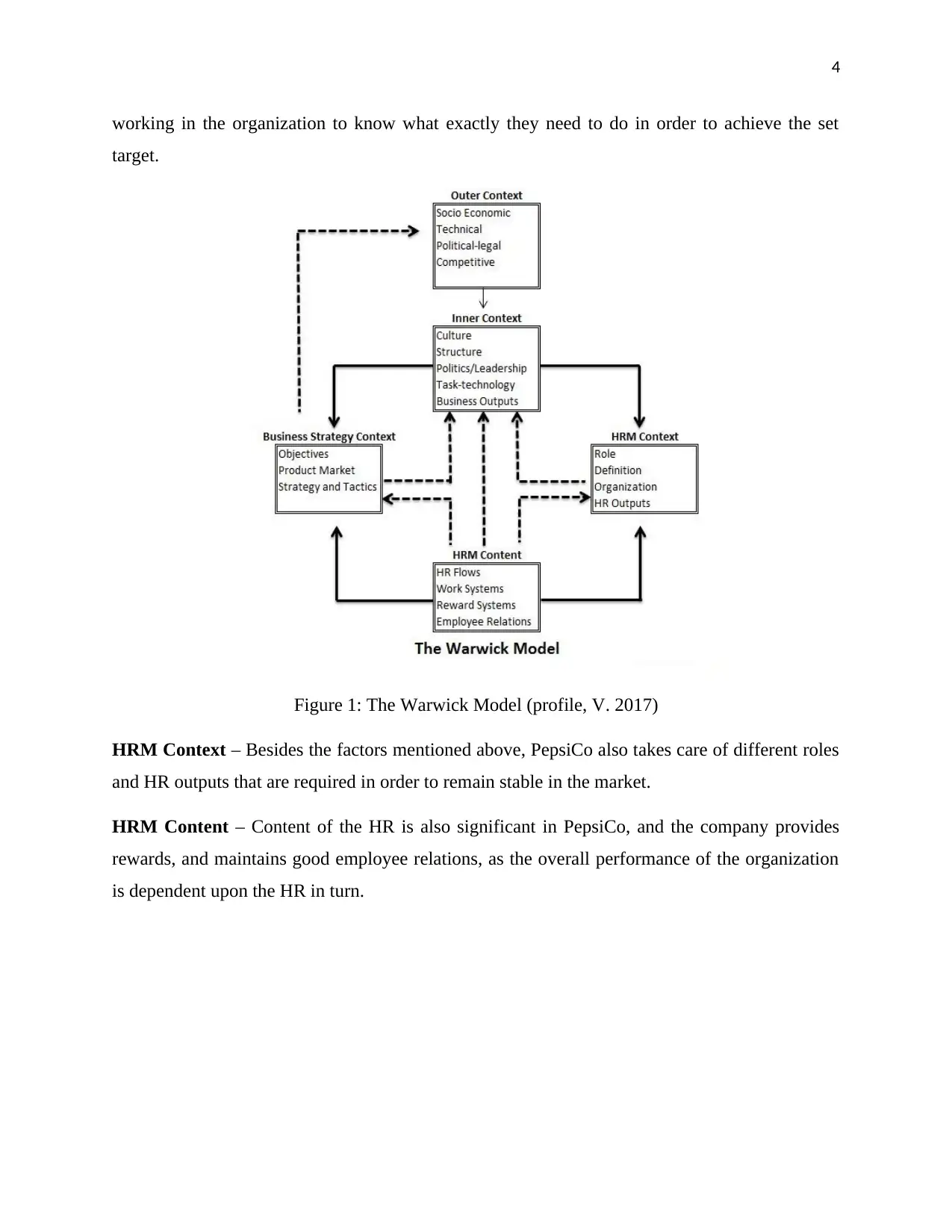
4
working in the organization to know what exactly they need to do in order to achieve the set
target.
Figure 1: The Warwick Model (profile, V. 2017)
HRM Context – Besides the factors mentioned above, PepsiCo also takes care of different roles
and HR outputs that are required in order to remain stable in the market.
HRM Content – Content of the HR is also significant in PepsiCo, and the company provides
rewards, and maintains good employee relations, as the overall performance of the organization
is dependent upon the HR in turn.
working in the organization to know what exactly they need to do in order to achieve the set
target.
Figure 1: The Warwick Model (profile, V. 2017)
HRM Context – Besides the factors mentioned above, PepsiCo also takes care of different roles
and HR outputs that are required in order to remain stable in the market.
HRM Content – Content of the HR is also significant in PepsiCo, and the company provides
rewards, and maintains good employee relations, as the overall performance of the organization
is dependent upon the HR in turn.
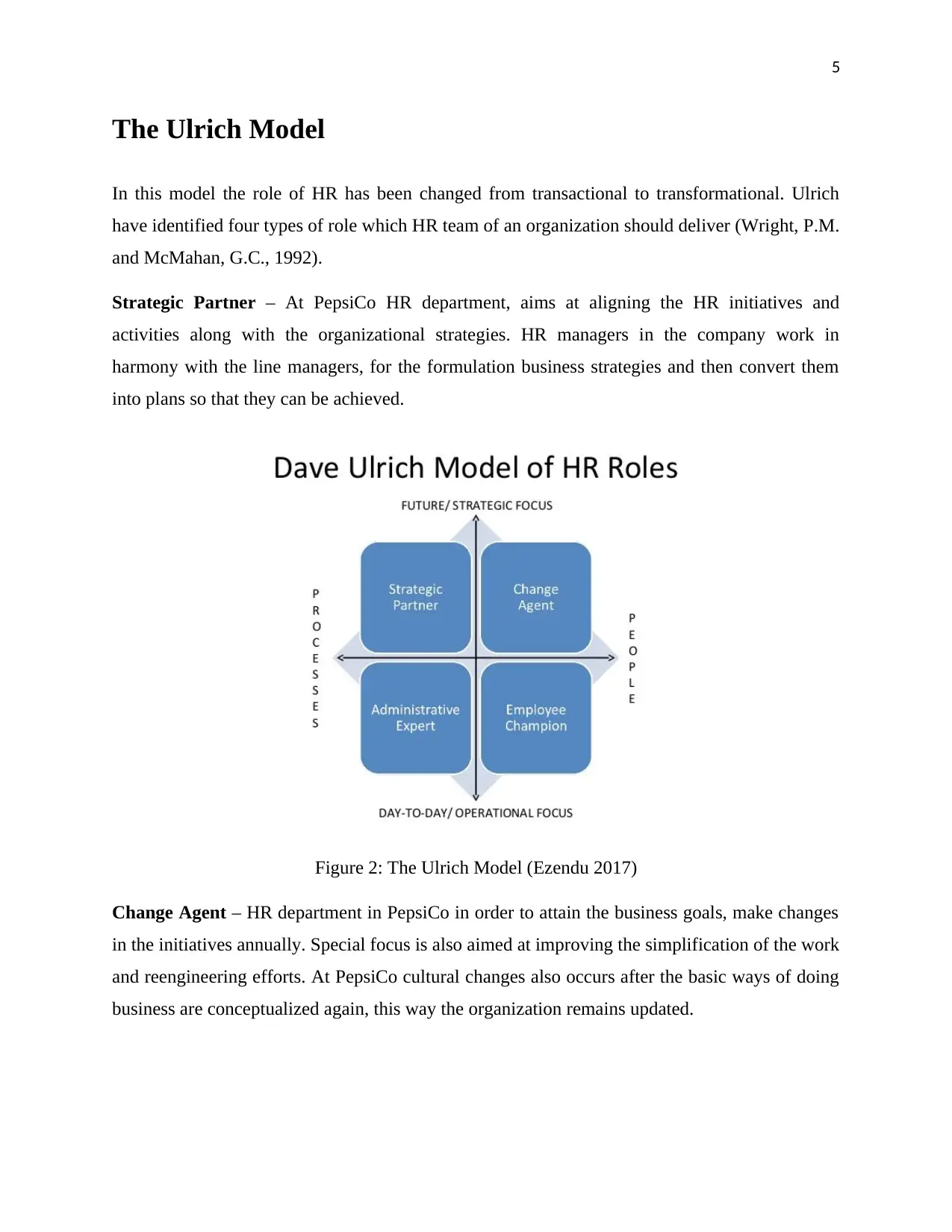
5
The Ulrich Model
In this model the role of HR has been changed from transactional to transformational. Ulrich
have identified four types of role which HR team of an organization should deliver (Wright, P.M.
and McMahan, G.C., 1992).
Strategic Partner – At PepsiCo HR department, aims at aligning the HR initiatives and
activities along with the organizational strategies. HR managers in the company work in
harmony with the line managers, for the formulation business strategies and then convert them
into plans so that they can be achieved.
Figure 2: The Ulrich Model (Ezendu 2017)
Change Agent – HR department in PepsiCo in order to attain the business goals, make changes
in the initiatives annually. Special focus is also aimed at improving the simplification of the work
and reengineering efforts. At PepsiCo cultural changes also occurs after the basic ways of doing
business are conceptualized again, this way the organization remains updated.
The Ulrich Model
In this model the role of HR has been changed from transactional to transformational. Ulrich
have identified four types of role which HR team of an organization should deliver (Wright, P.M.
and McMahan, G.C., 1992).
Strategic Partner – At PepsiCo HR department, aims at aligning the HR initiatives and
activities along with the organizational strategies. HR managers in the company work in
harmony with the line managers, for the formulation business strategies and then convert them
into plans so that they can be achieved.
Figure 2: The Ulrich Model (Ezendu 2017)
Change Agent – HR department in PepsiCo in order to attain the business goals, make changes
in the initiatives annually. Special focus is also aimed at improving the simplification of the work
and reengineering efforts. At PepsiCo cultural changes also occurs after the basic ways of doing
business are conceptualized again, this way the organization remains updated.
⊘ This is a preview!⊘
Do you want full access?
Subscribe today to unlock all pages.

Trusted by 1+ million students worldwide
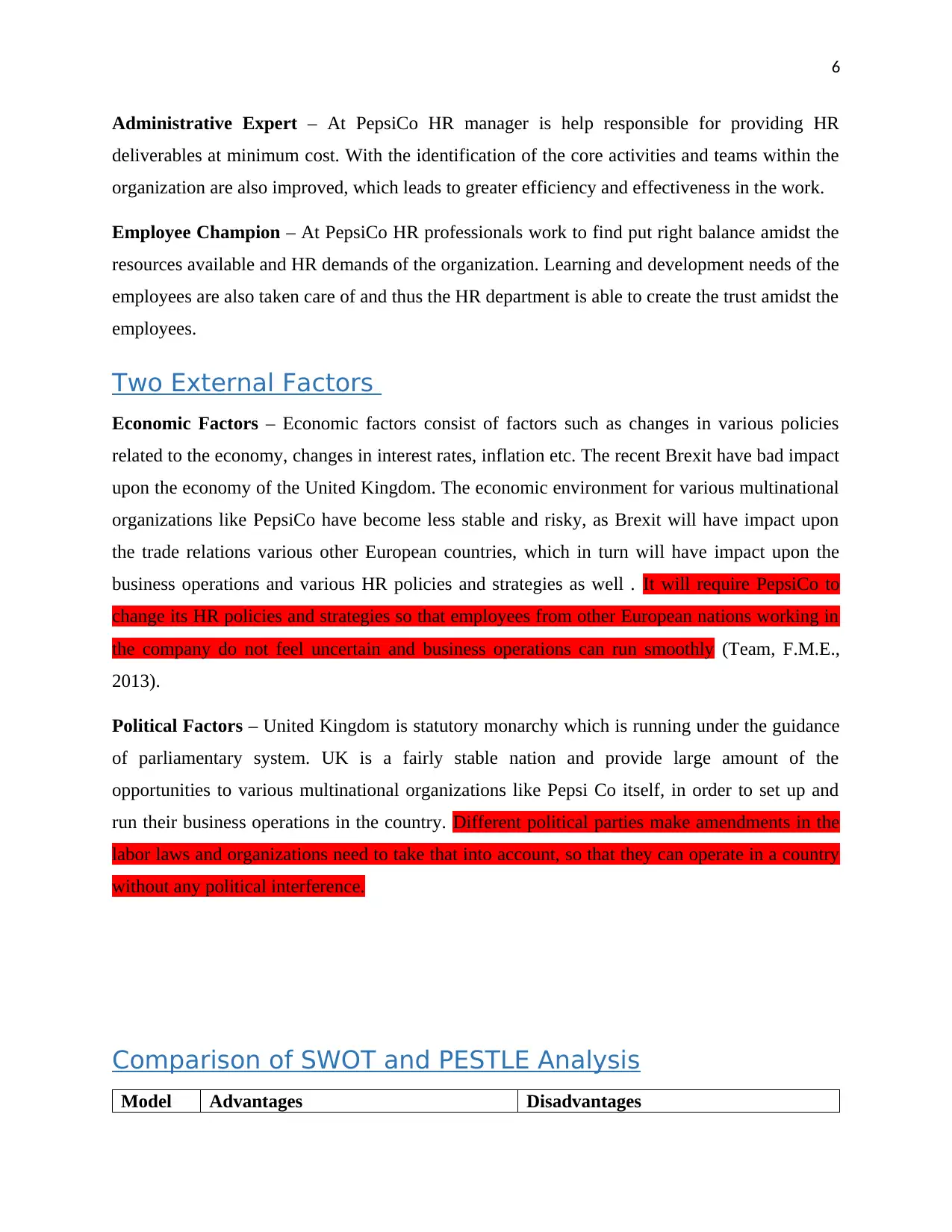
6
Administrative Expert – At PepsiCo HR manager is help responsible for providing HR
deliverables at minimum cost. With the identification of the core activities and teams within the
organization are also improved, which leads to greater efficiency and effectiveness in the work.
Employee Champion – At PepsiCo HR professionals work to find put right balance amidst the
resources available and HR demands of the organization. Learning and development needs of the
employees are also taken care of and thus the HR department is able to create the trust amidst the
employees.
Two External Factors
Economic Factors – Economic factors consist of factors such as changes in various policies
related to the economy, changes in interest rates, inflation etc. The recent Brexit have bad impact
upon the economy of the United Kingdom. The economic environment for various multinational
organizations like PepsiCo have become less stable and risky, as Brexit will have impact upon
the trade relations various other European countries, which in turn will have impact upon the
business operations and various HR policies and strategies as well . It will require PepsiCo to
change its HR policies and strategies so that employees from other European nations working in
the company do not feel uncertain and business operations can run smoothly (Team, F.M.E.,
2013).
Political Factors – United Kingdom is statutory monarchy which is running under the guidance
of parliamentary system. UK is a fairly stable nation and provide large amount of the
opportunities to various multinational organizations like Pepsi Co itself, in order to set up and
run their business operations in the country. Different political parties make amendments in the
labor laws and organizations need to take that into account, so that they can operate in a country
without any political interference.
Comparison of SWOT and PESTLE Analysis
Model Advantages Disadvantages
Administrative Expert – At PepsiCo HR manager is help responsible for providing HR
deliverables at minimum cost. With the identification of the core activities and teams within the
organization are also improved, which leads to greater efficiency and effectiveness in the work.
Employee Champion – At PepsiCo HR professionals work to find put right balance amidst the
resources available and HR demands of the organization. Learning and development needs of the
employees are also taken care of and thus the HR department is able to create the trust amidst the
employees.
Two External Factors
Economic Factors – Economic factors consist of factors such as changes in various policies
related to the economy, changes in interest rates, inflation etc. The recent Brexit have bad impact
upon the economy of the United Kingdom. The economic environment for various multinational
organizations like PepsiCo have become less stable and risky, as Brexit will have impact upon
the trade relations various other European countries, which in turn will have impact upon the
business operations and various HR policies and strategies as well . It will require PepsiCo to
change its HR policies and strategies so that employees from other European nations working in
the company do not feel uncertain and business operations can run smoothly (Team, F.M.E.,
2013).
Political Factors – United Kingdom is statutory monarchy which is running under the guidance
of parliamentary system. UK is a fairly stable nation and provide large amount of the
opportunities to various multinational organizations like Pepsi Co itself, in order to set up and
run their business operations in the country. Different political parties make amendments in the
labor laws and organizations need to take that into account, so that they can operate in a country
without any political interference.
Comparison of SWOT and PESTLE Analysis
Model Advantages Disadvantages
Paraphrase This Document
Need a fresh take? Get an instant paraphrase of this document with our AI Paraphraser
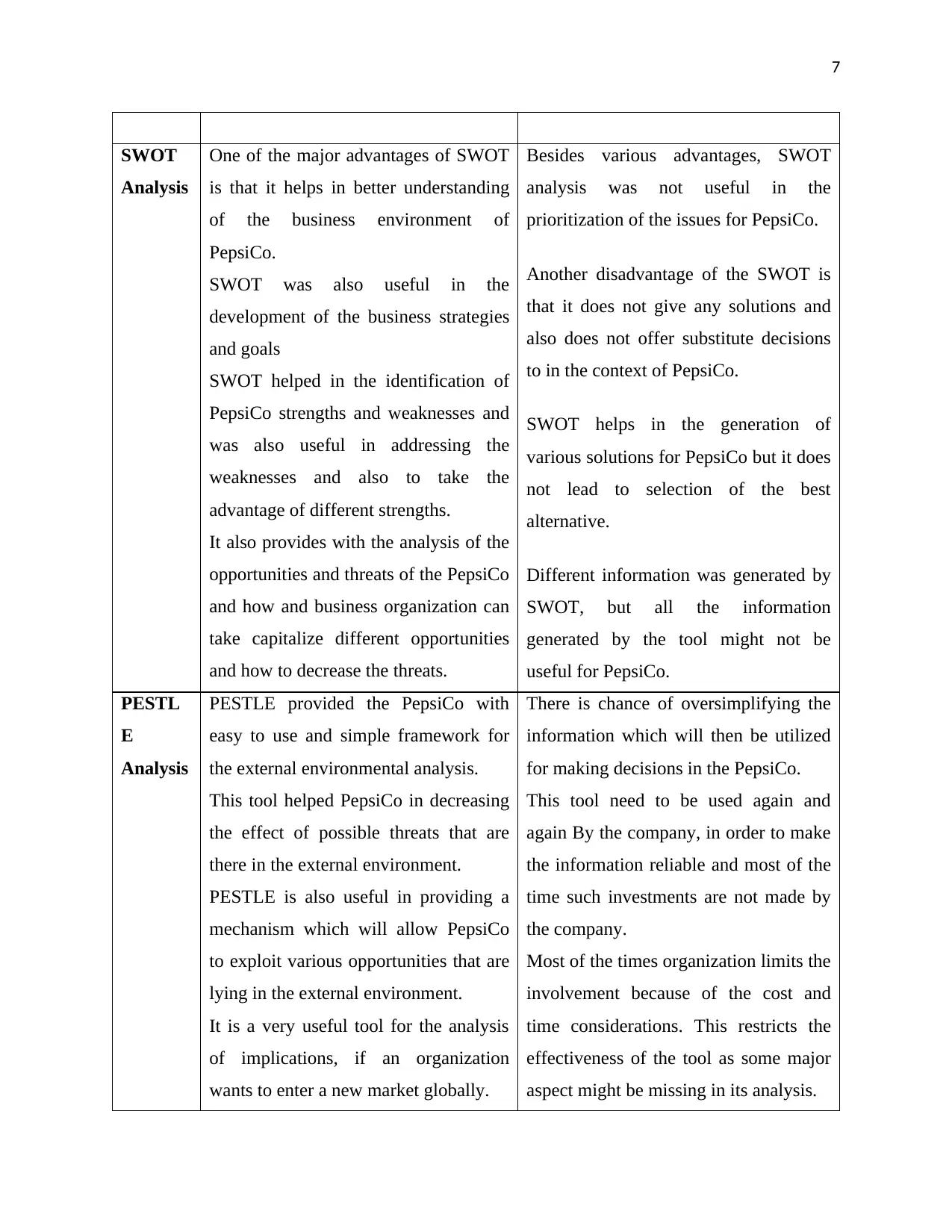
7
SWOT
Analysis
One of the major advantages of SWOT
is that it helps in better understanding
of the business environment of
PepsiCo.
SWOT was also useful in the
development of the business strategies
and goals
SWOT helped in the identification of
PepsiCo strengths and weaknesses and
was also useful in addressing the
weaknesses and also to take the
advantage of different strengths.
It also provides with the analysis of the
opportunities and threats of the PepsiCo
and how and business organization can
take capitalize different opportunities
and how to decrease the threats.
Besides various advantages, SWOT
analysis was not useful in the
prioritization of the issues for PepsiCo.
Another disadvantage of the SWOT is
that it does not give any solutions and
also does not offer substitute decisions
to in the context of PepsiCo.
SWOT helps in the generation of
various solutions for PepsiCo but it does
not lead to selection of the best
alternative.
Different information was generated by
SWOT, but all the information
generated by the tool might not be
useful for PepsiCo.
PESTL
E
Analysis
PESTLE provided the PepsiCo with
easy to use and simple framework for
the external environmental analysis.
This tool helped PepsiCo in decreasing
the effect of possible threats that are
there in the external environment.
PESTLE is also useful in providing a
mechanism which will allow PepsiCo
to exploit various opportunities that are
lying in the external environment.
It is a very useful tool for the analysis
of implications, if an organization
wants to enter a new market globally.
There is chance of oversimplifying the
information which will then be utilized
for making decisions in the PepsiCo.
This tool need to be used again and
again By the company, in order to make
the information reliable and most of the
time such investments are not made by
the company.
Most of the times organization limits the
involvement because of the cost and
time considerations. This restricts the
effectiveness of the tool as some major
aspect might be missing in its analysis.
SWOT
Analysis
One of the major advantages of SWOT
is that it helps in better understanding
of the business environment of
PepsiCo.
SWOT was also useful in the
development of the business strategies
and goals
SWOT helped in the identification of
PepsiCo strengths and weaknesses and
was also useful in addressing the
weaknesses and also to take the
advantage of different strengths.
It also provides with the analysis of the
opportunities and threats of the PepsiCo
and how and business organization can
take capitalize different opportunities
and how to decrease the threats.
Besides various advantages, SWOT
analysis was not useful in the
prioritization of the issues for PepsiCo.
Another disadvantage of the SWOT is
that it does not give any solutions and
also does not offer substitute decisions
to in the context of PepsiCo.
SWOT helps in the generation of
various solutions for PepsiCo but it does
not lead to selection of the best
alternative.
Different information was generated by
SWOT, but all the information
generated by the tool might not be
useful for PepsiCo.
PESTL
E
Analysis
PESTLE provided the PepsiCo with
easy to use and simple framework for
the external environmental analysis.
This tool helped PepsiCo in decreasing
the effect of possible threats that are
there in the external environment.
PESTLE is also useful in providing a
mechanism which will allow PepsiCo
to exploit various opportunities that are
lying in the external environment.
It is a very useful tool for the analysis
of implications, if an organization
wants to enter a new market globally.
There is chance of oversimplifying the
information which will then be utilized
for making decisions in the PepsiCo.
This tool need to be used again and
again By the company, in order to make
the information reliable and most of the
time such investments are not made by
the company.
Most of the times organization limits the
involvement because of the cost and
time considerations. This restricts the
effectiveness of the tool as some major
aspect might be missing in its analysis.
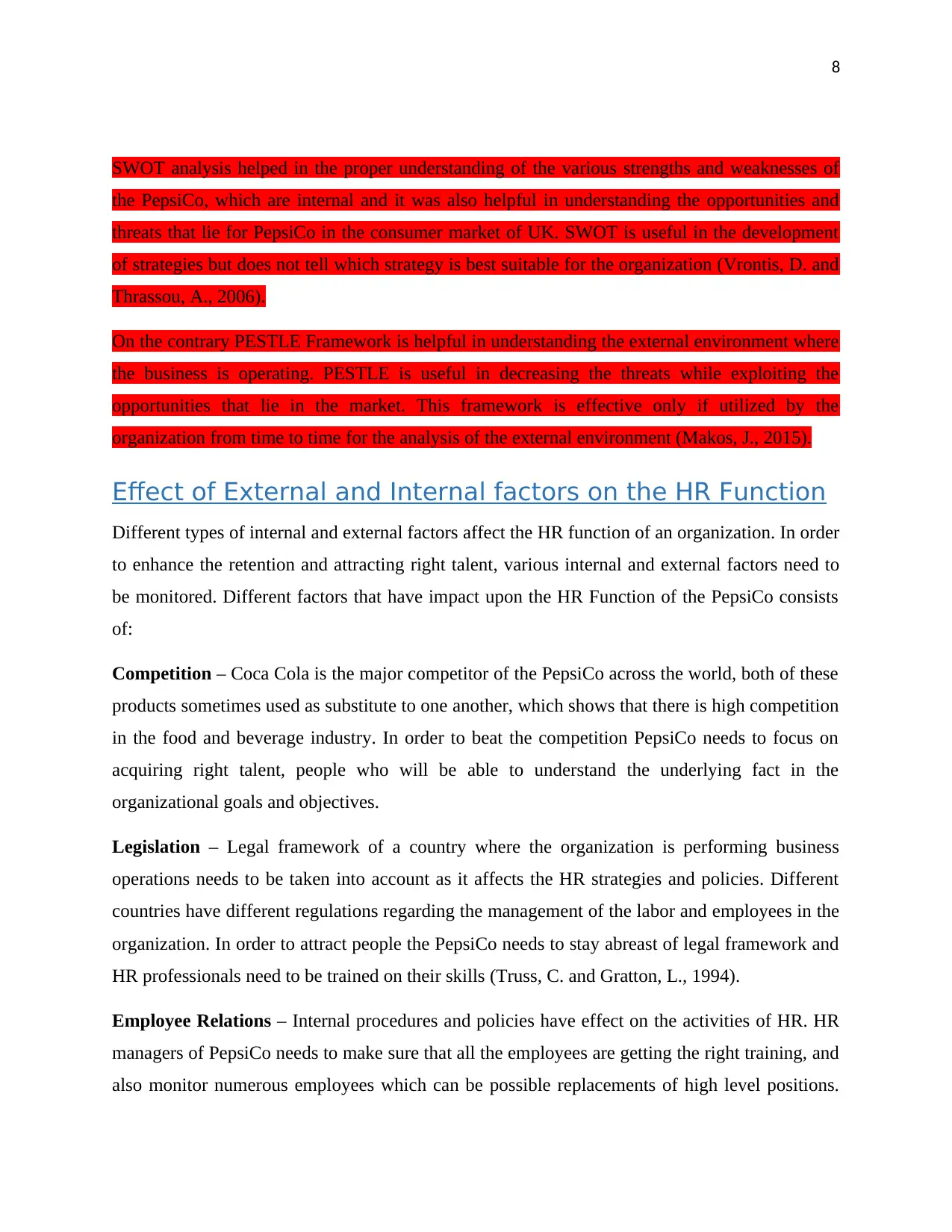
8
SWOT analysis helped in the proper understanding of the various strengths and weaknesses of
the PepsiCo, which are internal and it was also helpful in understanding the opportunities and
threats that lie for PepsiCo in the consumer market of UK. SWOT is useful in the development
of strategies but does not tell which strategy is best suitable for the organization (Vrontis, D. and
Thrassou, A., 2006).
On the contrary PESTLE Framework is helpful in understanding the external environment where
the business is operating. PESTLE is useful in decreasing the threats while exploiting the
opportunities that lie in the market. This framework is effective only if utilized by the
organization from time to time for the analysis of the external environment (Makos, J., 2015).
Effect of External and Internal factors on the HR Function
Different types of internal and external factors affect the HR function of an organization. In order
to enhance the retention and attracting right talent, various internal and external factors need to
be monitored. Different factors that have impact upon the HR Function of the PepsiCo consists
of:
Competition – Coca Cola is the major competitor of the PepsiCo across the world, both of these
products sometimes used as substitute to one another, which shows that there is high competition
in the food and beverage industry. In order to beat the competition PepsiCo needs to focus on
acquiring right talent, people who will be able to understand the underlying fact in the
organizational goals and objectives.
Legislation – Legal framework of a country where the organization is performing business
operations needs to be taken into account as it affects the HR strategies and policies. Different
countries have different regulations regarding the management of the labor and employees in the
organization. In order to attract people the PepsiCo needs to stay abreast of legal framework and
HR professionals need to be trained on their skills (Truss, C. and Gratton, L., 1994).
Employee Relations – Internal procedures and policies have effect on the activities of HR. HR
managers of PepsiCo needs to make sure that all the employees are getting the right training, and
also monitor numerous employees which can be possible replacements of high level positions.
SWOT analysis helped in the proper understanding of the various strengths and weaknesses of
the PepsiCo, which are internal and it was also helpful in understanding the opportunities and
threats that lie for PepsiCo in the consumer market of UK. SWOT is useful in the development
of strategies but does not tell which strategy is best suitable for the organization (Vrontis, D. and
Thrassou, A., 2006).
On the contrary PESTLE Framework is helpful in understanding the external environment where
the business is operating. PESTLE is useful in decreasing the threats while exploiting the
opportunities that lie in the market. This framework is effective only if utilized by the
organization from time to time for the analysis of the external environment (Makos, J., 2015).
Effect of External and Internal factors on the HR Function
Different types of internal and external factors affect the HR function of an organization. In order
to enhance the retention and attracting right talent, various internal and external factors need to
be monitored. Different factors that have impact upon the HR Function of the PepsiCo consists
of:
Competition – Coca Cola is the major competitor of the PepsiCo across the world, both of these
products sometimes used as substitute to one another, which shows that there is high competition
in the food and beverage industry. In order to beat the competition PepsiCo needs to focus on
acquiring right talent, people who will be able to understand the underlying fact in the
organizational goals and objectives.
Legislation – Legal framework of a country where the organization is performing business
operations needs to be taken into account as it affects the HR strategies and policies. Different
countries have different regulations regarding the management of the labor and employees in the
organization. In order to attract people the PepsiCo needs to stay abreast of legal framework and
HR professionals need to be trained on their skills (Truss, C. and Gratton, L., 1994).
Employee Relations – Internal procedures and policies have effect on the activities of HR. HR
managers of PepsiCo needs to make sure that all the employees are getting the right training, and
also monitor numerous employees which can be possible replacements of high level positions.
⊘ This is a preview!⊘
Do you want full access?
Subscribe today to unlock all pages.

Trusted by 1+ million students worldwide
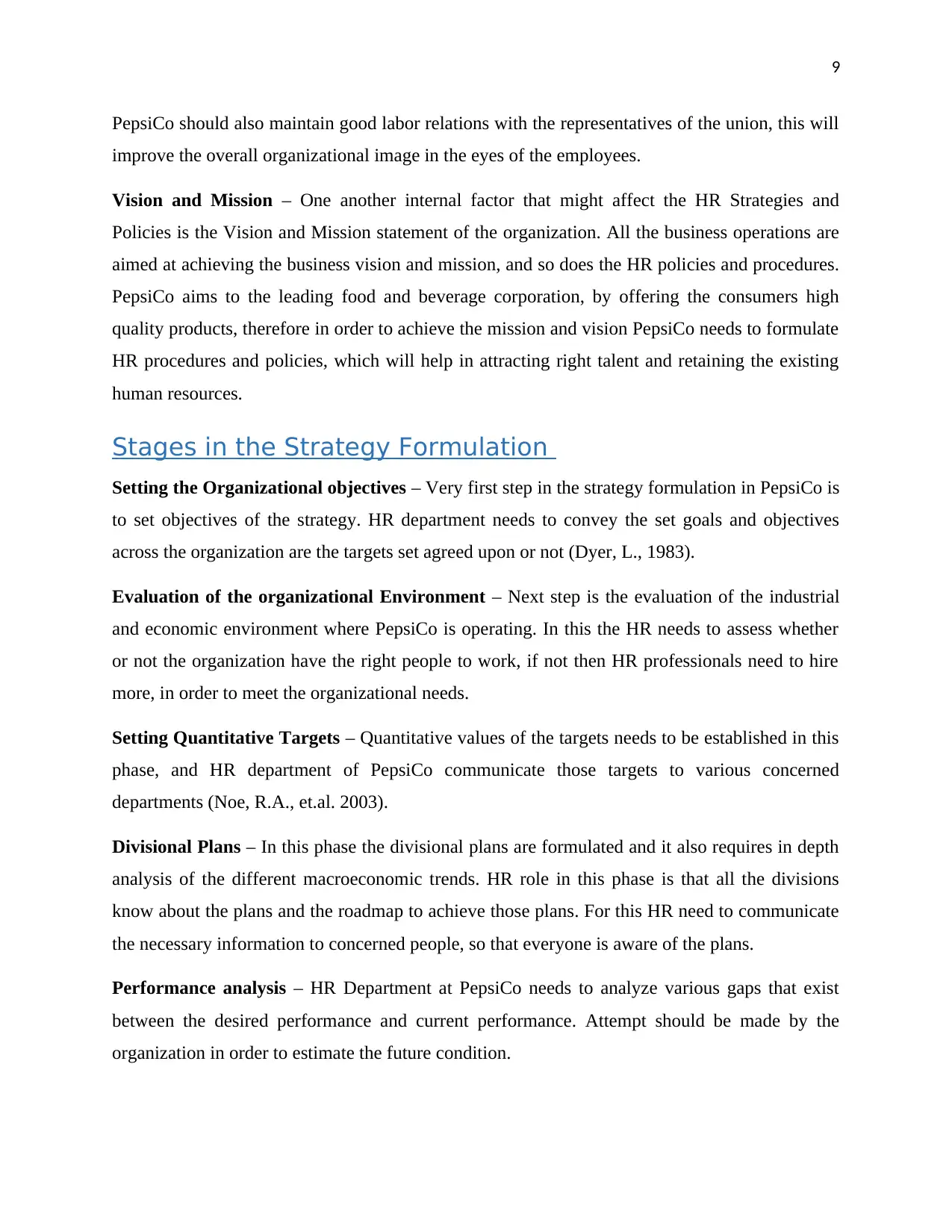
9
PepsiCo should also maintain good labor relations with the representatives of the union, this will
improve the overall organizational image in the eyes of the employees.
Vision and Mission – One another internal factor that might affect the HR Strategies and
Policies is the Vision and Mission statement of the organization. All the business operations are
aimed at achieving the business vision and mission, and so does the HR policies and procedures.
PepsiCo aims to the leading food and beverage corporation, by offering the consumers high
quality products, therefore in order to achieve the mission and vision PepsiCo needs to formulate
HR procedures and policies, which will help in attracting right talent and retaining the existing
human resources.
Stages in the Strategy Formulation
Setting the Organizational objectives – Very first step in the strategy formulation in PepsiCo is
to set objectives of the strategy. HR department needs to convey the set goals and objectives
across the organization are the targets set agreed upon or not (Dyer, L., 1983).
Evaluation of the organizational Environment – Next step is the evaluation of the industrial
and economic environment where PepsiCo is operating. In this the HR needs to assess whether
or not the organization have the right people to work, if not then HR professionals need to hire
more, in order to meet the organizational needs.
Setting Quantitative Targets – Quantitative values of the targets needs to be established in this
phase, and HR department of PepsiCo communicate those targets to various concerned
departments (Noe, R.A., et.al. 2003).
Divisional Plans – In this phase the divisional plans are formulated and it also requires in depth
analysis of the different macroeconomic trends. HR role in this phase is that all the divisions
know about the plans and the roadmap to achieve those plans. For this HR need to communicate
the necessary information to concerned people, so that everyone is aware of the plans.
Performance analysis – HR Department at PepsiCo needs to analyze various gaps that exist
between the desired performance and current performance. Attempt should be made by the
organization in order to estimate the future condition.
PepsiCo should also maintain good labor relations with the representatives of the union, this will
improve the overall organizational image in the eyes of the employees.
Vision and Mission – One another internal factor that might affect the HR Strategies and
Policies is the Vision and Mission statement of the organization. All the business operations are
aimed at achieving the business vision and mission, and so does the HR policies and procedures.
PepsiCo aims to the leading food and beverage corporation, by offering the consumers high
quality products, therefore in order to achieve the mission and vision PepsiCo needs to formulate
HR procedures and policies, which will help in attracting right talent and retaining the existing
human resources.
Stages in the Strategy Formulation
Setting the Organizational objectives – Very first step in the strategy formulation in PepsiCo is
to set objectives of the strategy. HR department needs to convey the set goals and objectives
across the organization are the targets set agreed upon or not (Dyer, L., 1983).
Evaluation of the organizational Environment – Next step is the evaluation of the industrial
and economic environment where PepsiCo is operating. In this the HR needs to assess whether
or not the organization have the right people to work, if not then HR professionals need to hire
more, in order to meet the organizational needs.
Setting Quantitative Targets – Quantitative values of the targets needs to be established in this
phase, and HR department of PepsiCo communicate those targets to various concerned
departments (Noe, R.A., et.al. 2003).
Divisional Plans – In this phase the divisional plans are formulated and it also requires in depth
analysis of the different macroeconomic trends. HR role in this phase is that all the divisions
know about the plans and the roadmap to achieve those plans. For this HR need to communicate
the necessary information to concerned people, so that everyone is aware of the plans.
Performance analysis – HR Department at PepsiCo needs to analyze various gaps that exist
between the desired performance and current performance. Attempt should be made by the
organization in order to estimate the future condition.
Paraphrase This Document
Need a fresh take? Get an instant paraphrase of this document with our AI Paraphraser
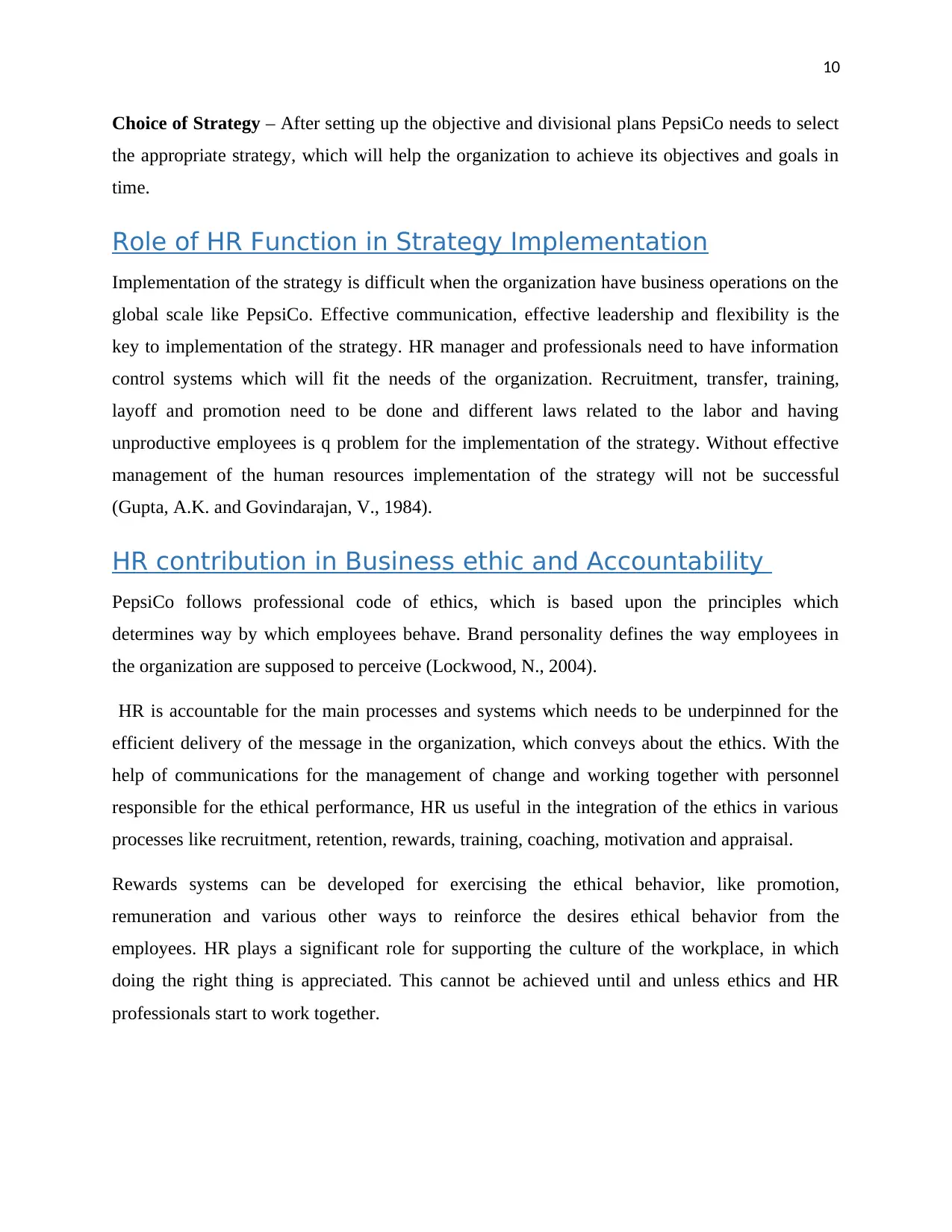
10
Choice of Strategy – After setting up the objective and divisional plans PepsiCo needs to select
the appropriate strategy, which will help the organization to achieve its objectives and goals in
time.
Role of HR Function in Strategy Implementation
Implementation of the strategy is difficult when the organization have business operations on the
global scale like PepsiCo. Effective communication, effective leadership and flexibility is the
key to implementation of the strategy. HR manager and professionals need to have information
control systems which will fit the needs of the organization. Recruitment, transfer, training,
layoff and promotion need to be done and different laws related to the labor and having
unproductive employees is q problem for the implementation of the strategy. Without effective
management of the human resources implementation of the strategy will not be successful
(Gupta, A.K. and Govindarajan, V., 1984).
HR contribution in Business ethic and Accountability
PepsiCo follows professional code of ethics, which is based upon the principles which
determines way by which employees behave. Brand personality defines the way employees in
the organization are supposed to perceive (Lockwood, N., 2004).
HR is accountable for the main processes and systems which needs to be underpinned for the
efficient delivery of the message in the organization, which conveys about the ethics. With the
help of communications for the management of change and working together with personnel
responsible for the ethical performance, HR us useful in the integration of the ethics in various
processes like recruitment, retention, rewards, training, coaching, motivation and appraisal.
Rewards systems can be developed for exercising the ethical behavior, like promotion,
remuneration and various other ways to reinforce the desires ethical behavior from the
employees. HR plays a significant role for supporting the culture of the workplace, in which
doing the right thing is appreciated. This cannot be achieved until and unless ethics and HR
professionals start to work together.
Choice of Strategy – After setting up the objective and divisional plans PepsiCo needs to select
the appropriate strategy, which will help the organization to achieve its objectives and goals in
time.
Role of HR Function in Strategy Implementation
Implementation of the strategy is difficult when the organization have business operations on the
global scale like PepsiCo. Effective communication, effective leadership and flexibility is the
key to implementation of the strategy. HR manager and professionals need to have information
control systems which will fit the needs of the organization. Recruitment, transfer, training,
layoff and promotion need to be done and different laws related to the labor and having
unproductive employees is q problem for the implementation of the strategy. Without effective
management of the human resources implementation of the strategy will not be successful
(Gupta, A.K. and Govindarajan, V., 1984).
HR contribution in Business ethic and Accountability
PepsiCo follows professional code of ethics, which is based upon the principles which
determines way by which employees behave. Brand personality defines the way employees in
the organization are supposed to perceive (Lockwood, N., 2004).
HR is accountable for the main processes and systems which needs to be underpinned for the
efficient delivery of the message in the organization, which conveys about the ethics. With the
help of communications for the management of change and working together with personnel
responsible for the ethical performance, HR us useful in the integration of the ethics in various
processes like recruitment, retention, rewards, training, coaching, motivation and appraisal.
Rewards systems can be developed for exercising the ethical behavior, like promotion,
remuneration and various other ways to reinforce the desires ethical behavior from the
employees. HR plays a significant role for supporting the culture of the workplace, in which
doing the right thing is appreciated. This cannot be achieved until and unless ethics and HR
professionals start to work together.
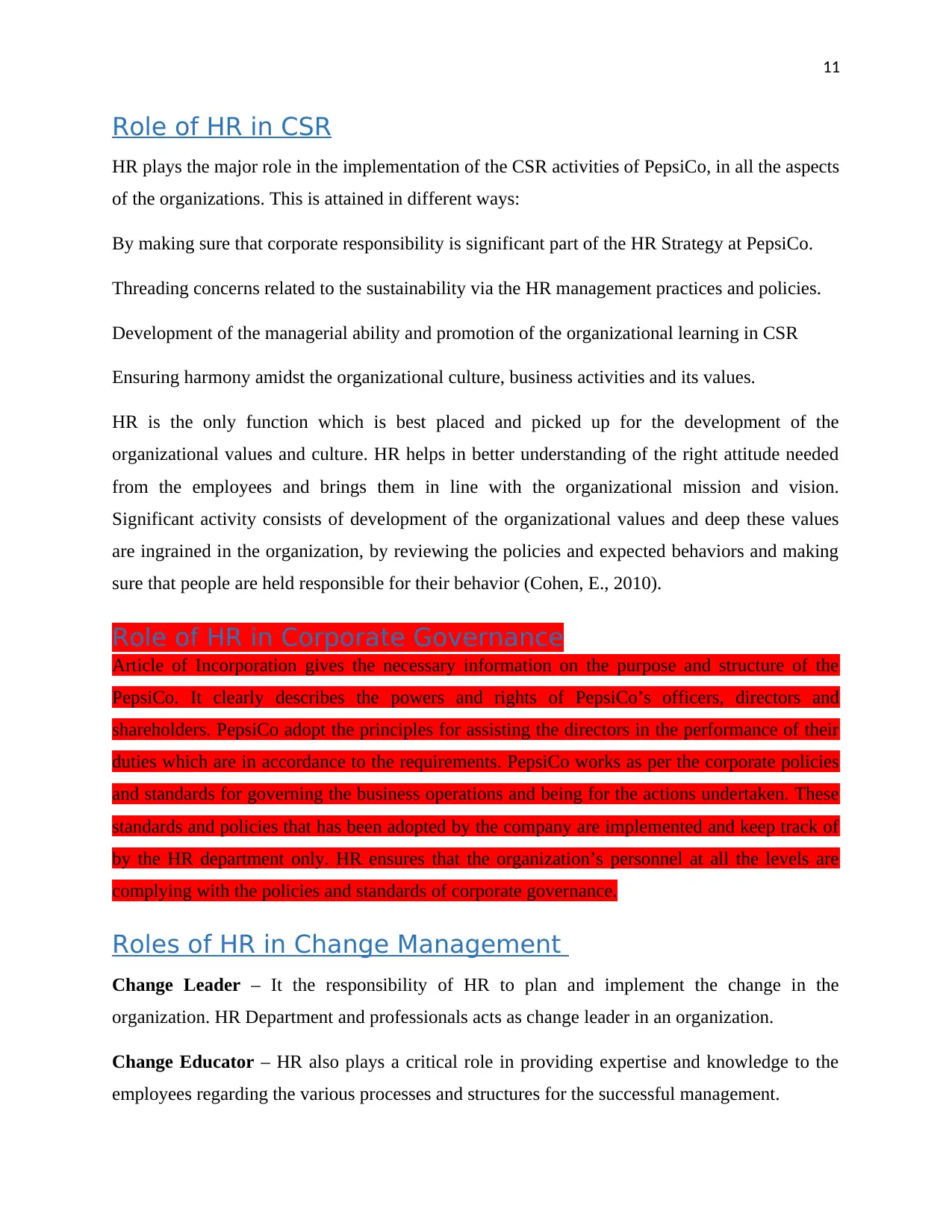
11
Role of HR in CSR
HR plays the major role in the implementation of the CSR activities of PepsiCo, in all the aspects
of the organizations. This is attained in different ways:
By making sure that corporate responsibility is significant part of the HR Strategy at PepsiCo.
Threading concerns related to the sustainability via the HR management practices and policies.
Development of the managerial ability and promotion of the organizational learning in CSR
Ensuring harmony amidst the organizational culture, business activities and its values.
HR is the only function which is best placed and picked up for the development of the
organizational values and culture. HR helps in better understanding of the right attitude needed
from the employees and brings them in line with the organizational mission and vision.
Significant activity consists of development of the organizational values and deep these values
are ingrained in the organization, by reviewing the policies and expected behaviors and making
sure that people are held responsible for their behavior (Cohen, E., 2010).
Role of HR in Corporate Governance
Article of Incorporation gives the necessary information on the purpose and structure of the
PepsiCo. It clearly describes the powers and rights of PepsiCo’s officers, directors and
shareholders. PepsiCo adopt the principles for assisting the directors in the performance of their
duties which are in accordance to the requirements. PepsiCo works as per the corporate policies
and standards for governing the business operations and being for the actions undertaken. These
standards and policies that has been adopted by the company are implemented and keep track of
by the HR department only. HR ensures that the organization’s personnel at all the levels are
complying with the policies and standards of corporate governance.
Roles of HR in Change Management
Change Leader – It the responsibility of HR to plan and implement the change in the
organization. HR Department and professionals acts as change leader in an organization.
Change Educator – HR also plays a critical role in providing expertise and knowledge to the
employees regarding the various processes and structures for the successful management.
Role of HR in CSR
HR plays the major role in the implementation of the CSR activities of PepsiCo, in all the aspects
of the organizations. This is attained in different ways:
By making sure that corporate responsibility is significant part of the HR Strategy at PepsiCo.
Threading concerns related to the sustainability via the HR management practices and policies.
Development of the managerial ability and promotion of the organizational learning in CSR
Ensuring harmony amidst the organizational culture, business activities and its values.
HR is the only function which is best placed and picked up for the development of the
organizational values and culture. HR helps in better understanding of the right attitude needed
from the employees and brings them in line with the organizational mission and vision.
Significant activity consists of development of the organizational values and deep these values
are ingrained in the organization, by reviewing the policies and expected behaviors and making
sure that people are held responsible for their behavior (Cohen, E., 2010).
Role of HR in Corporate Governance
Article of Incorporation gives the necessary information on the purpose and structure of the
PepsiCo. It clearly describes the powers and rights of PepsiCo’s officers, directors and
shareholders. PepsiCo adopt the principles for assisting the directors in the performance of their
duties which are in accordance to the requirements. PepsiCo works as per the corporate policies
and standards for governing the business operations and being for the actions undertaken. These
standards and policies that has been adopted by the company are implemented and keep track of
by the HR department only. HR ensures that the organization’s personnel at all the levels are
complying with the policies and standards of corporate governance.
Roles of HR in Change Management
Change Leader – It the responsibility of HR to plan and implement the change in the
organization. HR Department and professionals acts as change leader in an organization.
Change Educator – HR also plays a critical role in providing expertise and knowledge to the
employees regarding the various processes and structures for the successful management.
⊘ This is a preview!⊘
Do you want full access?
Subscribe today to unlock all pages.

Trusted by 1+ million students worldwide
1 out of 20
Related Documents
Your All-in-One AI-Powered Toolkit for Academic Success.
+13062052269
info@desklib.com
Available 24*7 on WhatsApp / Email
![[object Object]](/_next/static/media/star-bottom.7253800d.svg)
Unlock your academic potential
Copyright © 2020–2025 A2Z Services. All Rights Reserved. Developed and managed by ZUCOL.





